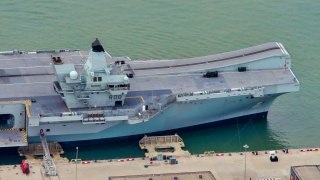The Royal Navy Has Wasted Billions on Aircraft Carriers That Barely Work
Building and operating aircraft carriers is complex, with only a few nations capable of it successfully. Recent issues with the British Royal Navy's carriers, HMS Queen Elizabeth and HMS Prince of Wales, highlight these challenges.
Summary and Key Points: Building and operating aircraft carriers is complex, with only a few nations capable of it successfully. Recent issues with the British Royal Navy's carriers, HMS Queen Elizabeth and HMS Prince of Wales, highlight these challenges.
-The Queen Elizabeth missed NATO exercises due to a propeller problem, while the Prince of Wales previously broke down with a similar issue.
-Both carriers have experienced other setbacks, including a minor fire and a collision involving other Royal Navy ships. These incidents raise concerns about the Royal Navy's ability to effectively operate and defend its aircraft carriers.
HMS Queen Elizabeth and Prince of Wales Aircraft Carriers: A Struggle to 'Stay Afloat'
No part of building and operating an aircraft carrier is simple. Few nations can pull it off. Just look at Russia’s Admiral Kuznetsov, which has been stuck in repairs for several years, unable to sail. Or consider the British, once rulers of the ocean, whose aircraft carriers have on more than one occasion had to skip NATO exercises.
Missing NATO Exercises
In February, the Associated Press reported that “a British aircraft carrier that had been set to lead the largest NATO exercises since the Cold War will not set sail…after a problem with its propeller was discovered during final checks.”
The aircraft carrier, the HMS Queen Elizabeth, had been scheduled to join exercises off the Arctic coast of Norway. Instead, the HMS Prince of Wales will take its place. Just in August 2022, it was the Prince of Wales that “broke down with a propeller problem on its way to carry out training exercises with the United States and Canada.” The carrier had to be towed all the way back to the Isle of Wight, and of course it was unable to participate in the exercises. The Queen Elizabeth subbed in.
With the Queen Elizabeth now out of commission, the Prince of Wales will lead Exercise Steadfast Defender with a carrier strike group of eight ships from the UK, U.S., Spain, and Denmark.
Not an Isolated Incident
The HMS Queen Elizabeth is a $3.7 billion flagship. Despite the remarkable cost, the vessel is proving to be problematic. Before missing NATO exercises with a bum propeller, the Queen Elizabeth caught fire while docked for repairs at Glen Mallon on Loch Long in Scotland. According to the Royal Navy, the fire was minor and caused no injuries.
“A minor, isolated fire on HMS Queen Elizabeth was quickly brought under control and extinguished,” a Royal Navy spokesperson said.
The Queen Elizabeth’s propeller problem was “the second setback for the Royal Navy in less than three weeks,” according to the Associated Press, “following a collision by two warships in a harbor in Bahrain, causing damage to the vessels but no injuries.”
In the collision, the HMS Chiddingfold appears to have reversed into the HMS Bangor while the latter vessel was docked. Both ships are minehunters stationed in the Middle East to help protect merchant vessels.
An Uncertain Future for the Royal Navy's Aircraft Carriers
Beyond the immediate maintenance problems, the Royal Navy does not seem capable of defending or operating their two aircraft carriers.
As Tom Sharpe acknowledged in the Telegraph: “Our carriers are a great capability but when they are fully formed, in some faraway time when we have a full complement of UK jets and other aircraft to put on them, they will never rival a U.S. Carrier Strike Group for the breadth of capability and firepower. This doesn’t mean they aren’t capable but they aren’t as capable as that.”
Sharpe elaborated, saying that British carriers suffer from inadequate airborne early warning systems, air-to-air refueling capabilities, and storage capacity.
About the Author: Harrison Kass
Harrison Kass is a defense and national security writer with over 1,000 total pieces on issues involving global affairs. An attorney, pilot, guitarist, and minor pro hockey player, Harrison joined the US Air Force as a Pilot Trainee but was medically discharged. Harrison holds a BA from Lake Forest College, a JD from the University of Oregon, and an MA from New York University. Harrison listens to Dokken.
Image Credit: Shutterstock.


